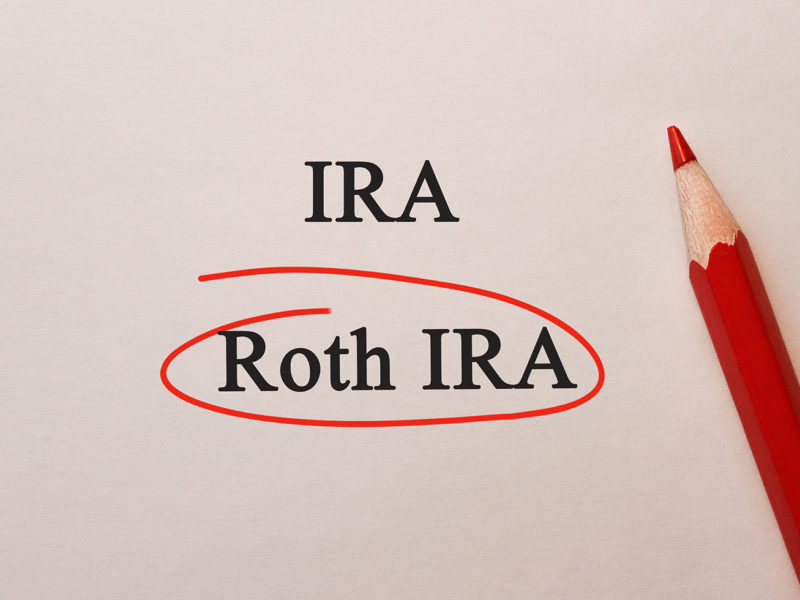At year end, it’s time to think about topping off your IRA and most people should be thinking about their Roth IRA. Choosing between a traditional IRA and a Roth IRA can have major tax and estate planning implications.
A traditional IRA has long been a favorite of people looking to save a little extra for retirement and get a bit more tax deduction. I recommend a Roth IRA over at traditional IRA to almost every client. Here’s why:
Roth IRA distributions are tax free.
One way to think about Traditional IRAs and Roth IRAs is: Pay me now or pay me later.
Pay me later: Traditional IRA
For tax year 2018, anyone under the age of 70½ who has earned income may make contributions of up to $5,500 per year to a traditional IRA ($6,500 per year if you are better than 50). Depending on the account holder’s income and a few other factors, these contributions are often fully tax deductible. Later withdrawals from the account are taxed as ordinary income.
Pay me now: Roth IRA
It’s different with a Roth IRA. You get no tax deduction for adding to a Roth IRA. You pay tax on your deposits in the year you earn the money. And, with a few exceptions, all future withdrawals will be tax free.
It could seem that the pay me now versus pay me later choice is a coin flip. But, when carefully considered, most people find the Roth IRA has some important advantages:
- Taxes. By taxing all distributions from a Traditional IRA you are paying tax on deposits and on growth. With a Roth IRA you pay tax on the deposits and not the growth.
- Long-term wealth accumulation. IRS rules require that Traditional IRA holders begin to remove money from the account before April 15 of the year following the year they turn 70 ½. At that time they are required to remove about 3.65 percent of the account value as of the prior December 31. This amount shows as income in the year it’s distributed. The required distributions continue until the account is empty or the IRA owner dies. An inheritor of the account must continue the distributions based on the heir’s age. Failure to meet this Required Minimum Distribution (it’s called an RMD) merits a 50 percent penalty added to the amount that was supposed to be distributed.
ROTH IRA owners do not have to remove money from the account. Ever. More money can remain sheltered from income taxes for longer in a Roth IRA.
- Penalties. Both IRA types allow distributions at age 59½ without penalty and both IRA types have penalties for distributions before that time.
- Traditional IRAs:
- All distributions before 59½ are taxed as income and a 10 percent penalty is assessed.
- After 59½ distributions are still taxed as income, but no additional penalty is in play.
- Roth IRAs:
- Contributions can be removed at any time with no
- Before the owner is aged 59½, any removal of growth is treated like a regular IRA distribution. The distribution is taxed as income and a 10 percent penalty is added. After age 59½ all Roth IRA distributions are tax free.
- Traditional IRAs:
- Estate transfer benefits. I already mentioned that Traditional IRA owners must remove money from the account starting at 70½ and that these RMDs must continue if the account is inherited at the owner’s death. Roth IRA owners are never required to remove money from the account and inheritors of the account are never taxed on distributions. But the heirs must take distributions based on their age according to IRS RMD rules.
So, it’s pretty clear that a Roth IRA is a great idea. If you are thinking of opening a Roth IRA you need to remember that individuals with an adjusted gross income of $135,000 or more, and married couples filing jointly with an AGI of $199,000 or more, cannot make contributions to a Roth IRA for tax year 2018.
If you are lucky enough to earn too much for a Roth IRA, it’s still possible to create a Roth IRA through IRA conversion, also known as the back-door method.
The process is a little tricky, so consult your CERTIFIED FINANCIAL PLANNER™ professional for help in funding a back door Roth IRA. While you are at it, be sure your planner is a is always an advocate for the client– a fiduciary advisor – and only works for the client – a fee-only advisor. That way, you can be confident that the financial advice you get is focused on your best interests and is a good fit for your complete financial situation.
Yes, I am a CFP® professional. I’m always a fiduciary and I only work on a fee basis. And yes, I’m still taking on a few great families to be part of my financial planning practice.
If this article has you asking questions, contact my office at rdunn@dunncreekadvisors.com. I am always happy to meet with people who are working on their financial goals. Dunncreek Advisors does not provide legal or tax advice, nor is this article intended to do so.


 8 Important Tasks For Your Financial Plan Before Year End
8 Important Tasks For Your Financial Plan Before Year End